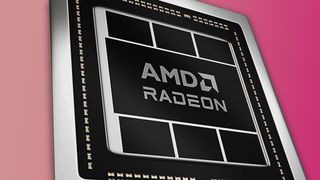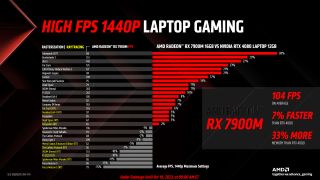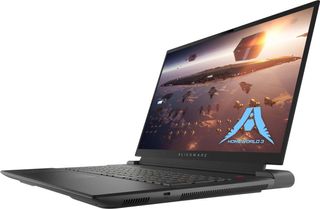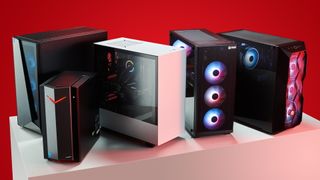AMD brings chiplets to Radeon Mobile at last with the new RX 7900M
And it's an Alienware laptop that'll be the first to show off its power.

Ten months after the first RDNA 3-powered laptop GPUs appeared, AMD has finally got around to using its premier Navi 31 processor in a mobile configuration. The new Radeon RX 7900M is being touted as being 7% faster on average than Nvidia's RTX 4080 Laptop, so fans of high-end gaming on the go might end up going all Team Red.
In terms of specs, just think Radeon RX 7900 GRE, but a little bit slower. Like all of the Radeon RX 7900-series models that use the RDNA 3-based Navi 31, this new GPU is a medium-sized lump of silicon, containing all of the graphics circuitry (called the GCD), surrounded by a number of tiny chiplets that house the L3 cache and memory interfaces (MCDs).
Something else that's common to them all is that the MCD is pretty much identical. In fact, the only differences are the number of active Compute Units (CUs) and the clock speeds used. In the case of the RX 7900M, you're getting 72 CUs with a game clock of 1,825MHz. For reference, the RX 7900 GRE sports 80 CUs and has a game clock of 1,880MHz.
The boost clock for the RX 7900M is 'up to 2,090MHz' because the value is really set by the laptop vendor. The maximum clock speed is limited by how much power the GPU is allowed to consume and in the case of this one, the specifications list a total graphics power of 'up to 180W'. So if the laptop has a lower limit than this, then the boost clock will be less than AMD's value.
Something else that it shares with the GRE card is the number of MCDs. This determines how much VRAM the GPU will have access to, along with the total width of the memory bus and the amount of L3 Infinity Cache. For the RX 7900M, it's 16GB of GDDR6, all running at 16Gbps (576GB/s of bandwidth) and 76MB of cache.
For me, the best thing about all of the RX 7900-series GPUs is they all have the same number of Shader Engines (SEs). Think of these as being like an apartment building that houses all of the facilities you need and for a graphics chip, that means something to manage threads, rasterize triangles, crunch shaders, and carry out render operations.

Since they have six SEs, every RX 7900 also sports 192 ROPs (render operation units) but since the RX 7900M has the least number of shaders in the range, it means the GPU will almost never be ROP-limited in a game. Not that this is usually a major problem, but it's significantly more ROPs than in Nvidia's RTX 4080 Laptop, which just has 80 of them.
The biggest gaming news, reviews and hardware deals
Keep up to date with the most important stories and the best deals, as picked by the PC Gamer team.
For high resolution gaming, especially at high frame rates, having lots of ROPs is a good thing.
In terms of raw metrics, the RX 7900M is definitely better than the RTX 4080 Laptop, but then again, so it should be. Nvidia uses the AD104 for this model, which is a smaller GPU than the Navi 31, even in this cut-down form. It also has a lower peak power limit of 150W but if the prices for RX 7900M laptops are similar to RTX 4080 ones, then it doesn't really matter.

The first laptop that's being sold with the RX 7900M is Alienware's m18. It's only available in a specific configuration that uses an AMD Ryzen 9 7945HX, 32GB of DDR5-5200, and 1TB of storage for a pricey $2,800 and that's $50 less than a configuration using a Ryzen 9 7845HX and an RTX 4080 Laptop GPU.
If you're not worried about using ray tracing in games, then the RX 7900M configuration is the better of the two. However, if you're looking for the best performance in the latest rendering tricks, then the RTX 4080 is probably the one to pick.

Best gaming PC: The top pre-built machines.
Best gaming laptop: Great devices for mobile gaming.
Personally, I'd still go with AMD's new GPU. I think it's a better match for the 18-inch 1920 x 1200, 480Hz screen used in the Alienware m18 laptop, and for just outright gaming, the RX 7900M looks really good. Best to wait for reviews and benchmarks, though, before taking the plunge as $2,800 is a lot of money to spend on a laptop.
I'm glad that we can finally get a Navi 31 GPU in a laptop but ten months is far too long a time to bring this to market. Nvidia's had all of its mobile RTX 40-series out since the beginning of this year and it's hard enough to find a laptop with a decent AMD GPU as it is. With so many vendors churning out Nvidia-powered gaming laptops, discounts are quite frequent, too.
If Dell isn't joined by a large number of other companies in adopting the RX 7900M, there's a good chance that AMD's fine graphics processor will hardly see the light of day.

Nick, gaming, and computers all first met in 1981, with the love affair starting on a Sinclair ZX81 in kit form and a book on ZX Basic. He ended up becoming a physics and IT teacher, but by the late 1990s decided it was time to cut his teeth writing for a long defunct UK tech site. He went on to do the same at Madonion, helping to write the help files for 3DMark and PCMark. After a short stint working at Beyond3D.com, Nick joined Futuremark (MadOnion rebranded) full-time, as editor-in-chief for its gaming and hardware section, YouGamers. After the site shutdown, he became an engineering and computing lecturer for many years, but missed the writing bug. Cue four years at TechSpot.com and over 100 long articles on anything and everything. He freely admits to being far too obsessed with GPUs and open world grindy RPGs, but who isn't these days?
Most Popular






